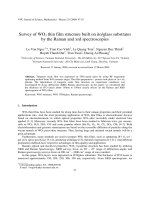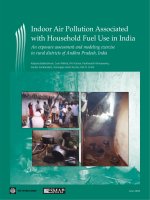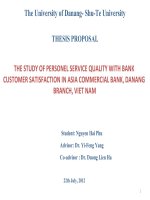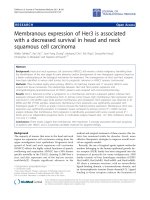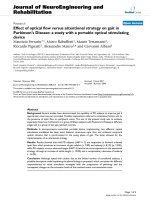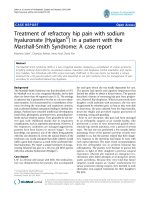Oromo indigenous religion anthropological understanding of waaqeffannaa nature link, with highlight on livelihood in guji zone, adola redde and girja districts
Bạn đang xem bản rút gọn của tài liệu. Xem và tải ngay bản đầy đủ của tài liệu tại đây (3.67 MB, 134 trang )
OROMO INDIGENOUS RELIGION: ANTHROPOLOGICAL UNDERSTANDING OF
WAAQEFFANNAA-NATURE LINK, WITH HIGHLIGHT ON LIVELIHOOD IN GUJI
ZONE, ADOLA REDDE AND GIRJA DISTRICTS
BY MULUGETA JALETA GOBENO
A THESIS SUBMITTED TO THE DEPARTMENT OF SOCIAL ANTHROPOLOGY, COLLEGE
OF SOCIAL SCIENCE ADDIS ABABA UNIVERSITY
IN PARTIAL FULFILLMENT FOR REQIREMENTES OF THE DEGREE OF MASTERS OF
ARTS IN SOCIAL ANTHROPOLGY
MENTOR: ASSEFA TOLERA (PhD)
JUNE 2017
ADDIS ABABA UNIVERSITY
ADDIS ABABA UNIVERSITY
SCHOOL OF GRADUATE STUDIES
DEPARTMENT OF SOCIAL ANTHROPOLOGY
MA PROGRAM IN SOCIAL ANTHROPOLOGY
OROMO INDIGENOUS RELIGION: ANTHROPOLOGICAL UNDERSTANDING OF
WAAQEFFANNAA-NATURE LINK, WITH HIGHLIGHT ON LIVELIHOOD IN GUJI
ZONE, ADOLA REDDE AND GIRJA DISTRICTS
BY MULUGETA JALETA GOBENO
MENTOR: ASSEFA TOLERA (PHD)
JUNE 2017
OROMO INDIGENOUS RELIGION: ANTHROPOLOGICAL UNDERSTANDING OF
WAAQEFFANNAA-NATURE LINK, WITH HIGHLIGHT ON LIVELIHOOD IN GUJI
ZONE, ADOLA REDDE AND GIRJA DISTRICTS
BY MULUGETA JALETA GOBENO
A THESIS SUBMITTED TO THE SCHOOL OF GDRADUATE STUDIES OF ADDIS
ABABA UNIVESITY, IN PARTIAL FULFILLMENT OF THE REQUIREMENTS FOR THE
DEGREE OF MASTER OF ARTS IN SOCIAL ANTHROPOPLOGY
MENTOR: ASSEFA TOLERA (PHD)
JUNE 2017
ADDIS ABABA UNIVERSITY
SCHOOL OF GRADUATE STUDIES
OROMO INDIGENOUS RELIGION: ANTHROPOLOGICAL UNDERSTANDING OF
WAAQEFFANNAA-NATURE LINK, WITH HIGHLIGHT ON LIVELIHOOD IN GUJI
ZONE, ADOLA REDDE AND GIRJA DISTRICTS
BY MULUGETA JALETA GOBENO
APPROVED BY BOARD OF EXAMINERS
Chair Person, Graduate committee
Signature
______________________________
____________
Advisor
Signature
______________________________
____________
Examiner
Signature
_______________________
_________
Examiner
Signature
_______________________
_________
Date
____________
Date
____________
Date
_________
Date
_________
Acknowledgements
I kindly, thank and appreciate my Mentor Dr. Assefa Tolera, for his immeasurable effort and
diligent support in guiding, motivating and correcting me, throughout this study. His
encouragement to present the draft of this study as prospective MA student on the occasion of 25th
Anniversary of the MA Program in Social Anthropology at Addis Ababa University on 29th & 30th
of September 2016 is unforgettable.
I appreciate, the constructive and motivating comments forwarded to me, on the above mentioned
event, from all my instructors at AAU and national & international participants, such as Professor
Evo, Professor Indris & his colleague from Sudan, and Dr. Taddesse Berisso.
My third thanks, goes to my wife Lenssa Endalu, who paid thoughtful sacrifice, to save the life of
our first child, Loti Mulugeta, who was saved for a little from medical technical shortfall related
case during delivery. Being in the Hospital, she encouraged me not to miss class. We are lucky
on both side.
Fourthly, I would like to express my deep appreciation and gratitude to the three Abba Gada of the
Guji three phratry Uraga, Matti & Hokku respectively. The cooperation and contribution of Abba
Gada of Uraga (Guji Oromo senior phratry) and Abba Gada of Matti phratry is larger.
At last but not least, I appreciate individuals who dedicatedly worked on the process of recognition
of Gada System by UNESCO, announced in November, which by chance made me a student of
good Kayyo /Milkii as it was after my field work which ended in the mid-September 2016.
-I-
ABSTRACT
The aim of this thesis is to investigate and identify the Oromo Indigenous Religion (IR)Waaqeffannaa link to natural environment (Land and forest), and its values in all aspects of Guji
Oromo life, in the anthropological lens. In this study, the what, where and why Waaqeffannaa
persistently deep-rooted in to the daily life of Guji-Oromo and their amicable co-existence with
nature have been discussed and analyzed. The study employed qualitative research approach with
ethnographic research design, because of the nature of the identified research problem, that
peoples’ experience in the environment, and belief system and practices to be studied. The actual
study participants have been selected by means of non-probability sampling method, from Adola
Redde and Girja districts. Purposive sampling has been employed in this study, because, the
relevant respondents from the target group have been selected carefully, by the researcher, to get
reliable and rich data. Ethical issues strongly respected. Detailed interview, Focused group
discussion, Observation, Informal conversation and Document review are data gathering tools
employed. The sample size of this study depends on the saturation of data collected. Data
collection and organizations took place in August and September 2016, while interpretation, and
analysis took place in October to December 2016. Girja and Adola Redde Districts have been
identified as study population due to their potential resource fullness which is useful to this study.
This study argued that Indigenous Religion (IR) -Waaqeffannaa contributed to the existence and
preservation of natural environment, which in turn, natural environment has contributed for the
existence of conducive conditions for all lives both human and non-human nature in that area. As
a result people of the area enjoyed diversified livelihoods due to favorable climatic conditions.
Waaqeffannaa link with nature is more of spiritual and socio-economical in nature. Therefore,
there is lesson to learn from ancestors that this study found and more studies recommended to be
conducted for more lesson.
Key words: Abba Gada, Gada System, Waaqa, Waaqeffannaa, Guji-Oromo, Balli, Qallu, ArdaaJilaa
-II-
ACRONYMS
CSA-Central Statistical Agency
FGD-Focused Group Discussion
GCTB-Guji Culture and Tourism Bureau
IK-Indigenous Knowledge
IR-Indigenous Religion
MAE-Meteorological Agency of Ethiopia
SNNPR-Southern Nations Nationalities and Peoples Regions
SNNP- Southern Nations Nationalities and Peoples
-III-
Dedication
This thesis is dedicated to my mother Tajitu Ragassa Gammachu, who laid the corner stone of my
educational life building, from non to current and where I will be next. Sadly, she is not sharing
this world with me. Moreover, this study is dedicated to lives lost on Irrecha Thanks Giving Day
on October 2. 2016 and all lives lost in 2015-2016 in the country.
-IV-
LIST OF DIAGRAMS, MAPS, PICTURES, AND STRUCTURES
I. Diagrams
Diagram 1. Diagram depicts Oromo world view in the three embedded Entities.. ……. 29
Diagram 2. Guji Oromo Gada baallii (Gada Cycle) ……………………………….…….….51
Diagram 3. Waaqeffannaa-Nature influence cycle……………………………….…….……90
II. Maps
Map 1. Administrative Map of Oromia Region and the study sites….………………………36
Map 2. Physical Map of Ethiopia ………………………………………………………….....…38
Map3. Indicative sketch Map of the three phratries Cultural Movement in their Gabala .45
III. Pictures
Pic 1. Liben Lark in the forest of Guji Oromo …………………………………….………..….37
Pic 2. Picture taken at Ardaa-Jilaa Milkii where Abba Gada of Uraga team temporarily
sheltered…………………………………………………………………………………………….. 40
Pic 3. Ardaa-Jilaa Haro Gobbu On the bank of Ganalle River disects the two study sites
(Adola Redde and Girja) ………………………………………………………………………………….41
Pic.4 Interview with the two Uraga & Matti phratries Abba Gada at
Ardaa-Jilaa Milkii……………….………………………………………………………………..42
Pic 5. Picture taken at Ardaa Jilaa Sodduu Dhibaayyuu where Hokku phratry
temporarily sheltered………………………………………………………………..…..42
Pic 6. Religious conference close to Ardaa-Jilaa Maleekkaa …..………….…………..…..72
Pic 7. Trees planted on Male & female Graves……………………………….…………..….75&76
Pic.8. Picture depicts crops on Farm land…………………………………………….......….81
-V-
Pic.9. Picture depict farmland close to forest……………………………………………..…..82
Pic.10 Farmers with their agro-pastoral activities products……………………………..…83
Pic.11 Photograph taken during observation in Girja District, Harenfama
town market place,…………………………………………………………..……………….……84
Pic.12 Liben district pastoralists leading their Livestock to river in country side livestock ………………………………………………………………………………..………..….….85
Pic.13 Malekka Town Friday Market Forest product as goods………………………........87& 88
Pic.14. Cleared forest in Guji zone between Malekka and Anfarara forest…………........89
Pic.15. Group of people holding drum and emotionally singing met on
the side of street between Girja and Adola Redde district………………….….….95
IV. STRUCTURES
Structure 1. . Guji Oromo Traditional Social Organization………………………….……..53
Structure 2. Uraga phratry Sub –Social Organization ………………………..…………..…53
Structure 3. Matti phratry Sub. Social Organization……………………………………..……54
Structure 4. Hokku phratry Sub-Social Organization…………………………….……………54
Structure 5. Gada System hierarchy …………………………………………….……………….57
-VI-
GLOSSARY OF LOCAL WORDS
Abbaa coomaa- (Rosmarinus officinalis)
Abba –Father
Ardaa Jilaa-Sacred sites
Baca –Many/Much
Baallii- Gada Cycle
Gaalee –dependent plant like rope (no scientific name)
Gabala –Traditional Administrative area in Guji Oromo
Haadha-Mother
Haadha bollaa- title given to wife of Abba Gada
Harrettii/qoddoo- (no scientific name),
Hayyuu- Wise / Knowledgeable person
Hosee- Good
Ka dhibii- Another
Kaayyoo/Milkii- Luck
Marga maattii (Taj-sar in Amharic and no scientific name),
Muka- Jilaa-sacred tree
Qadadduu-Supporter
Qaalluu- Oromo indigenous religion leader
Sukutee – (tena-adam in Amharic and no scientific name),
Waaqa-Supper Natural Being
Waaqa-Heaven/ Sky
Waaqeffataa-Folower of Waaqeffannaa (Masculine)
Waaqeffattuu-Folower of Waaqeffannaa (Feminine)
-VII-
Waaqeffannaa-Indigenous Oromo Religion
Wolannaa- Opposite groups in Guji Oromo Gada cycle
Woyyuu-Holy, Someone with special talent,
-VIII-
Table of Contents
Acknowledgements……………………………………………………………….............…….-IAbstract…………………………………………………………………………….…………..-IIAcronyms ……………………………………………………………………………...……..-IIIDedication……………………………………………………………………....……………..-IVCHAPTER ONE: ................................................................................................................................... - 4 Introduction ............................................................................................................................................ - 4 -
1.1. Background ...................................................................................................................... - 4 1.2. Statement of the Problem ................................................................................................. - 6 1.3. Objectives of the study ..................................................................................................... - 9 1.4. Research questions: .......................................................................................................... - 9 1.5. Significance of the study .................................................................................................. - 9 1.6. Scope of the study .......................................................................................................... - 10 1.7. Research Methodology and Methods ............................................................................. - 10 1.7.1. Research Methodology ........................................................................................................ - 10 1.7.2. Research design.................................................................................................................... - 10 1.7.3. Study Population .................................................................................................................. - 11 1.7.4. Sampling Method ................................................................................................................. - 11 1.7.5. Sampling Technique ............................................................................................................ - 11 1.7.6. Sample Size .......................................................................................................................... - 12 1.7.7. Data Gathering Methods ...................................................................................................... - 12 1.7.8. Data Analysis ....................................................................................................................... - 16 1.7.9. Limitation of the study ......................................................................................................... - 16 1.8.1. Epistemological Stance ........................................................................................................ - 17 1.8.2. Ethical Consideration ........................................................................................................... - 17 -
1.9. Organization of the Study .............................................................................................. - 18 CHAPTER TWO ................................................................................................................................. - 19 Review of the Related Literature ........................................................................................................ - 19 -
2.1. Conceptual Framework .................................................................................................. - 19 2.2. Theoretical Framework .................................................................................................. - 20 2.2.1. Theory of Cultural Ecology ................................................................................................. - 21 2.2.2. Interpretive / Symbolic Anthropology ................................................................................. - 23 -1-
2.3. Literature on Waaqa and Waaqeffannaa ........................................................................ - 24 2.3.1 Three Conceptual Oromo Worldview ................................................................................... - 26 -
2.4. The Conceptual meaning of Ritual ................................................................................ - 30 CHAPTER THREE ............................................................................................................................. - 32 Historical and Socio-Culutral Overview of the Oromo nation with focus on Guji Oromo ........... - 32 -
3.1. Guji Oromo .................................................................................................................... - 34 3.2. Guji Oromo Indigenous Religion, .................................................................................. - 39 3.2.2. Guji Oromo Gada system ............................................................................................ - 45 3.2.3. Guji Oromo Social Organization ......................................................................................... - 52 CHAPTER FOUR................................................................................................................................ - 55 Ritual practices in Guji Oromo .......................................................................................................... - 55 -
4.1. Woyyu ............................................................................................................................. - 55 4.1.1. Woyyu in the aspects of humanity ........................................................................................ - 55 4.1.2. Woyyu in the aspect of non-human nature ........................................................................... - 56 -
4.2. Hayyu ............................................................................................................................. - 56 4.3. Kayyo .............................................................................................................................. - 57 4.5. The influence of Waaqeffannaa and some rituals .......................................................... - 58 4.5.1. Malxuu (Puffing) Ritual ....................................................................................................... - 61 4.5.2. Hulluuqqaa Ritual ................................................................................................................ - 66 4.5.3. Bita-baafannaa “Siding-left” Ritual .................................................................................... - 67 -
4.6. “Universality” of Waaqeffannaa .................................................................................... - 69 CHAPTER FIVE ................................................................................................................................. - 73 Lafa (Land) and Guji Oromo Livelihood .......................................................................................... - 73 -
5.1. Lafa (Land)..................................................................................................................... - 73 5.2. Perception of Lafa (Land) beyond earthly life ............................................................... - 74 5.3. The Guji Oromo Livelihood (Jiruuf- jireenya) .............................................................. - 78 5.1.1. Agro-pastoralisme ................................................................................................................ - 79 5.1.2. Livestock .............................................................................................................................. - 84 5.1.3. Forest product ...................................................................................................................... - 86 CHAPTER SIX .................................................................................................................................... - 91 -
Summary of the Study, Concluding Remarks and Recommendations ................................. - 91 6.1. Summary of the Study findings ...................................................................................... - 91 6.2. Concluding Remarks ...................................................................................................... - 98 -
-2-
6.3. Recommendations ........................................................................................................ - 101 BIBLIOGRAPHIES .......................................................................................................................... - 103 APPENDICES .................................................................................................................................... - 107 -
Annex (I) ............................................................................................................................. - 107 The three abba gada, and group of people accompanying the jila march ........................... - 107 Annex (II) Guiding Questions ............................................................................................. - 109 B. Guiding question checklist ............................................................................................. - 115 Annex (III) Identified Ardaa Jilaa (Sacred Sites) in the Study area ................................... - 116 Annex (IV) Glossary of Plant Names ................................................................................. - 119 Annex (V)............................................................................................................................ - 122 Names of Days in a Month (Maqoota Guyyaa Ji’a/ baatii keessaa) according to Guji Oromo
Callendar ............................................................................................................................. - 122 -
-3-
CHAPTER ONE:
Introduction
1.1. Background
Religious practices are one of the major valued human experiences that possess several purposes,
and meanings in the history of mankind. It is very important to understand religion and its
practices, in one way or another, as it has power to affect daily life. Taylor mentioned that failing
to understand religion would result in failing to understand the world in which we are today. “You
cannot understand the world today if you do not understand religion” (Taylor 2007: xiii).
Indigenous religions have their own values, and function to the people they serve. Oromo belief
system -“Oromo Religion” as Bartels calls, Waaqeffannaa is one of the indigenous religions in
Africa. Some studies explained Waaqeffannaa as one of the major indigenous African religions.
According to (Baxter, Hultin & Triulzi 1996), Oromo religion is one of the very few indigenous
religions that have not been dominated by foreign religions. “Unlike other people who have
adopted religions from which were not indigenous to their societies, in the case of Oromo, the
people and the belief system have evolved together” (94).
Waaqeffannaa of the Oromo is among such indigenous religions, which survived for a long periosd
of time. Of course, large number of Oromo have been converted to either Christianity or Islam
religions, while significant number remained with their indigenous religion. This indigenous
religion is practical in different parts of Oromia in varying degrees.
The way Guji and Borana Oromo practice their indigenous religion-Waaqeffannaa, wherever and
whenever there are events and shrines, and value, respect, protect and special attentions given to
nature surrounding them, in their daily life, influenced and drove me to be curious about the Guji
Oromo and their indigenous religious practices in the natural environment, to know more. I
repeatedly travel to both Guji and Borana zones for humanitarian activities since the last six years.
I have observed and impressed by the different natural environment that covered Guji zone which
includes high altitude with thick forest and its biodiversity, middle altitude, lowland and
geographical landscape. For me, it cannot be an exaggeration, if I say, the friendly bond between
-4-
this people and the natural environment with its all components (both plants and animals lives) on
this land has attention pulling.
Natural environment is holy place where prayer and religious ritual takes place in Guji Oromo
land. Religious and socio-political rituals and practices are in the natural environment like forest,
fields, under trees and on the bank of water bodies. This is the very nature of humanity in the
history of mankind as Wade explains. “Primitive religions have no priests or ecclesiastical
hierarchy. They are practiced by the community as a whole, with no distinction of rank. No
separate organizations such as a church is recognized the entire community is a church” (Wade,
2009:101).
Places are not just ordinary places, but place which is irreplaceable and unchangeable, and have
certain taboos. Sites of religious and cultural rituals, respected and protected by all, and transferred
from generation to generation. No matter how much the sacred site is far away from the people,
they did not establish another place. Rather, they perform pilgrimage to such sacred sites because
of the value attached to that place through ancestral line. According to Taddesse, (1995:48), “These
shrines are common properties of the whole group and were found all over the Guji territory,
covering vast areas of land. Guji performs pilgrimage to these sites for Gada and other rituals”
The complex cultural background of this people, that supported them in keeping such diverse
natural environment, since at least more than half a millennia, is perhaps, because of the influences
of their complex indigenous religion, socio-cultural and political practices which is friendly to
nature. Indigenous religion (Waaqeffannaa) which is the very heart of the culture of Guji Oromo,
takes a lion’s share, in every aspects of Guji Oromo life.
However, so far, no detail studies conducted on this indigenous belief system-Waaqeffannaa and
its link to nature as far as the researcher knows. Thus, the researcher is interested to understand
what Waaqeffannaa is for this people? Where, and how Guji Oromo Waaqeffannaa practiced?
Why Waaqeffannaa, is in the nature unlike other dominant religions, and Waaqeffannaa value
attachment to natural environment?
-5-
These lines of tracing knowledge helps the researcher to learn the link between Waaqeffannaa
practices and selected natural environment. Milton (1996) has mentioned that the importance of
studying local knowledge is both for knowledge gap as well as to protect environment in relatively
best way as locals have understanding of the real world than others. “There are many instances in
which the knowledge anthropologists have gained of people’s understandings of their
environments would support the view (widely held among environmentalists) that the best way of
protecting those environments is to enable local, traditional cultures to survive” (53).
1.2. Statement of the Problem
A number of social science researches have been conducted on Guji Oromo under different titles
and objectives. For instance, (Hinnant, T. John 1977), has studied The Gada system of Guji of
Southern Ethiopia, in which he has elaborated the social structure, “traditional” political system,
and some of the roles of Qallu on religion events during ritual practices (Hinnant 1977). Hinnant
indicated that the Qallu who are socially, the highly respected and heard individual, and indigenous
religion leader, was much knowledgeable in Guji-Oromo culture.
However, he met such an individual suddenly, on ritual practice where groups of people attending
their religious ritual, practices at the end of his study.
By the end of the field work period, I had access to hundreds of people, was in regular attendance
in two spirit groups and knew the official Guji historian, the leaders of the Gada system, and the
high Kallu, the most important religious figure in Guji. Yet I learned more from my adopted father
than from these specialists. They knew specific aspects of Guji culture more than anyone else
(Hinnant 1977: ix).
This indicates, there is more lesson to learn the religious aspect of the culuture. Indigenous religion
(Waaqeffannaa) is the center of the whole Guji Oromo culture.
Secondly, the practices of this Indigenous religion in the other parts of Oromia has two nature. The
first is Thanks Giving to Waaqa following end of rainy season and beginning of spring. The idea
is to thank Waaqa for his ending rainy, cloudy, muddy ground and replacing with sunshine and
flowery environment. This ritual is called irrecha/irressa and performed in the nature, usually, on
-6-
the bank of water bodies (Lake or river side). No studies indicate about ritual performance for
Waaqa’s giving of raining up on request so far.
This thanks giving ceremony-irrecha/irressa, has a re-cycling nature because its performance at
the end of rainy season specifically in the mid September when natural environment decorated
with yellow flowers on annual base and celebrated in different parts of Oromia but the number
of participants are not in millions like the big irrecha ceremony at Hora Arsade in Bishoftu town
45 kms to the south of Addis Ababa.
The second nature of Waaqeffannaa is request for intervention of Waaqa in to some problems.
The request can be for human or animal epidemic diseases, delayed rain, instability, repeated
accident and repeated deaths in a family or a community to Waaqa through ritual performance. As
events happen unexpectedly, such form of Waaqeffannaa – requesting Waaqa for intervention
performed irregularly unlike the abovementioned thanksgiving ritual. It has no specific time base
unlike irrecha-thanks giving elaborated above.
In brief, Waaqeffannaa can be seen in two explicit ways. The former is thanks giving which is
time based and has recycling nature while the later is request for help or intervention of Waaqa
when ever needed.
However, in the case of Guji Oromo, Waaqeffannaa rituals have no fixed time, and purpose. It is
quite complex, and diversified. Therefore:
1. The reason behind these differences between other parts of Oromia and Guji Oromo,
remained open and needs answer.
2. What is the influence of such Waaqeffannaa (daily life based) in Guji Oromo on natural
environment?
3. The third issue remained open is the practical outcom of natural environment on Guji
Oromo due to their different ways of Waaqeffannaa they practice?
Therefore, to fill the above mentioned gaps this study is focused on Waaqeffannaa-Natural
environment link with highlight on livilihoods of the Guji Oromo in the anthropological light. The
-7-
ritual practices of Waaqeffannaa in these selected natural environment, where Ardaa-Jilaa found
were the very heart of this study.
Guji zone is selected due to the availability of such religiously important sacred lands which
indicate the presence of relatively larger followers of Waaqeffannaa in Guji land than other parts
of Oromia, as earlier researches findings reveal. “Culturally sacred sites are more available in GujiOromo occupied lands than Borana Oromo (Asmarom 1973:17); (Hinnant 1977); (Taddesse,
1995:48).
Moreover, the rationale behind the abundance of sacred places in one area (more in Adola Redde
districts) than the other areas within Guji land itself needs more explanatios. This study considered
to analyze these natural environment which is culturally protected places beyond just being
“ceremonial place”. Dove and Carpenter argued that, Places are not just locals but source of
feelings, meanings and memories of past experiences; there is power to identify who and what we
are yesterday and analyze in the lens of where we are now.
…there is now an “impressive array” of anthropological research demonstrating that “places are
locales of intense emotional attachment, think with meaning and memory, shaped by both local and
trans-local phenomena; they possess the ‘power to direct and stabilize us, to memorize and identify
us, to tell us who and what we are in terms of where we are (as well as where we are not)’ (Dove
and Carpenter, 2008:53).
The argument of this study is on this indigenous religion-Waaqeffannaa link to selected natural
environment (Land and Forest as sacred sites), and its effects on the natural environment, which
in turn, has influence on the way of life of the Guji Oromo.
The source of primary data for this study were the community, who are regular participants of the
rituals at Ardaa-Jiala and those who used to participate in different rituals and ceremonies as well.
The religious values attached to such natural environment, why such natural environments selected
religiously? The influence of Waaqeffannaa on human action against natural environment, and
the natural environment effect on the way of life and daily life of the Guji Oromo have been studied
in depth in the anthropological lens.
-8-
1.3. Objectives of the study
The general objective of this study is to understand and examine Oromo indigenous religion (IR)
-Waaqeffannaa link with natural environment, in the anthropological understanding.
The specific objectives of this study are:
To understand Waaqeffannaa belief system among the Guji Oromo;
To analyze Waaqeffannaa value attachment;
Values attached to Natural environment;
To analyze Waaqeffannaa influence on natural environment
To examine the influence of natural environment on the Guji Oromo’s livelihoods.
1.4. Research questions:
This research answer the following questions:
What is Waaqeffannaa for the Guji Oromo?
What are the values attached to Waaqeffannaa?
What are valuea attached to Natural environment?
What are Waaqeffannaa influences on natural environment?
What are natural environment influences on livelihoods and daily life of the Guji
Oromo?
1.5. Significance of the study
Religious practices are one of the major valued human experience that possess complex meanings,
and influences human mind. It is important to understand religion and its practices, as in one way
or another, it has a power to affect daily life. This study discussed Oromo Indigenous religion
practices in the natural environment among Guji Oromo and has the following significance.
Oromo indigenous religion –Waaqeffannaa is among such indigenous religions. This study
focused stressed on the significance and function of this indigenous Oromo religions
(Waaqeffannaa) practices in the natural environment among Guji Oromo. Therefore, it has the
following significance:
-9-
It uncover information (purpose, value attachment, link with nature and roles of
individuals in the system) about what indigenous religion of Oromo-Waaqeffannaa is
among the Guji Oromo
It would have an added value and may contribute to the few available Waaqeffannaa nature related researches
It would serve as an introductory to further research to be studied in depth in such
indigenous religion and physical world tie, to pave the way for “Environmental
anthropology” to open as field of study in the department of Social Anthropology.
1.6. Scope of the study
Because of time and budget constraints it has been found difficult to conduct research in all districts
of Guji zone. Thus, this study delimited to two districts- Adola Redde and Girja of Gji Zone in
Oromia regional state.
There are twenty eight (28) kebeles and three (3) town admnistrations in Adola Redde district while
there are twenty kebeles in Girja district. This study has been delimited to eight (8) kebeles and
two (2) town administrations in Adola Redde and four (4) kebeles in Girja districts respectively.
In Both sites, kebeles where Ardaa-Jilaa (Sacred sites) are available and the current Gada leaders
with their followers were performing ceremonies and rituals have been selected.
1.7. Research Methodology and Methods
1.7.1. Research Methodology
As this study is concerned with less measurable human experiences, it is significant to consider
appropriate research methodology and methods to address the research problem accurately.
Therfore, qualitative research approach has been employed as it is relevant for this particular study
due to the nature of the research problem addressed. Because, the study is lived experiences of
human which cannot be quantified.
1.7.2. Research design
The researcher chosed ethnographic research design in this study because it is appropriate to
qualitative research methodology and more useful to understand the cultural and religious practices
of the people; it is also helpful to understand social structure and organizations of the study
- 10 -
population accurately. This is due to the fact that the thesis is about Peoples’ lived experience and
their interaction with their natural environment.
1.7.3. Study Population
The study population of the research were two districts (Adola Redde and Girja) in Guji zone,
Oromia Regional State, where Matti and Hokku, Guji Oromo sub groups predominantely
inhabited. The study has been conducted in kebeles such as Bachara, Michicha, Darartu, Qiltu
Sorsa, Oda Buta, Dole, Anfarara, Sakarro and Abulo Rukessa in Adola Redde District and two
towns’ administrations namely Adola Woyu and Maleka, in Adola Redde.
In Girja district there are (20) kebeles. Out of these the study has been conducted in four, QallinaGobu, Harenfama-Dhebissa, Harenfama-Qallina and Harenfama kebels respectively. There are a
number of Ardaa-Jilaa (Sacred sites) in both districts which are protected by the community reside
surrounding them. The number of Ardaa-Jilaa in Adola Redde is larger than the number in Girja
district. These study sites were selected due to their potential resource richness for this study as
the current Gada leaders were slowly moving in these villages located in the two districts.
1.7.4. Sampling Method
Non probability sampling method employed in this study. The actual study participants have been
selected from Guji zone, Adola Redde and Girja districts by means of non-probability sampling
method.
1.7.5. Sampling Technique
Purposive sampling technique has been applied, because, the relevant respondents from the target
group have been selected by the researcher carefully, to seek relevant, rich and reliable data. Abba
Gada of the three Guji phratries-Uraga, Matti and Hokku with their followers, were involved in
this research. This technique used to get in depth information from all segments of population
understudy such as elders, religious leaders, and youth, of both sex among Guji Oromo inhabited
in Adola Redde and Girja districts.
The idea behind qualitative research is to purposefully select participants or sites (or documents or
visual material) that will best help the researcher understand the problem and the research question.
- 11 -
This does not necessarily suggest random sampling or selection of a large number of participants
and sites, as typically found in quantitative research (Creswell 2014: 239).
1.7.6. Sample Size
The sample size of this study depended on the saturation of the data collected; as number of
respondents in the qualitative research design determined when the data shows repetition. Data
collection stopped when replication started.
1.7.7. Data Gathering Methods
Data collection methods applied in this study were:
In-depth interview
Focussed Group Discussion
Observation
Informal conversation and
Document review
Indeed, all questions cannot be answered in a single method because of various factors. Each
method has its own strong and weak sides. In this research, gaps in each method were filled by the
other methods applied orderly to make data more complete and accurate.
As a primary source of data, the above listed first four methods wereselected. Data from the four
tools crosschecked to enhance credibility of the data producing power of the study. Some
photographs related to the study taken on the field have been used as supportive information for
the data.
Instruments prepared in both Afan Oromo and English versions. The English version was not used
in the field. It is prepared to be attached to this thesis to make clear for the reader what type of
questions used in the field. The indepth interview, Focus group discussion, Observation and
informal conversation mainly consisted of basic concept of Waaqeffannaa and natural
environment variables and specific interview questions focused on the link between the two
variables in complimentary sense, when the target groups practice Waaqeffannaa rituals in their
daily lives in the study sites.
Three Sacred sites, namely Ardaa-Jilaa Milkii, Ardaa-Jilaa Dhibaayyu Soodduu, were observed
in the presence of Abba Gada with their team while Ardaa Jilaa Haro Gobbu (Malkaa-Gannaalee)
- 12 -
was observed in the absence of the followers of the religion. Data collection took place at the first
two Ardaa-Jilaa Milki 80 kms from Adola Woyu town where the two senior Guji groups (Uraga
and Matti temporarly sheltered for ritual activities. Hokku the junior Guji Oromo groups met for
data collection at Ardaa- Jilaa Dhibaayuu Soodduu-some 20kms away from Adola Woyu town.
As the groups travel slowly on the basis of their indigenous calendar, the researcher visited the
third Ardaa-Jilaa Ardaa-Jilaa Haro Gobbu (Malkaa Gannaalee) without the presence of Abba Gada
with their followers.
1.7.7.1. Indepth Interview
The key informants of this study were diversified and carefully selected. Both male and female
from culturally knowledgeable elders, Qalluu (Waaqeffannaa leaders) family, Abba Gada
(indigenous socio-political leaders) with their social structures and Haadha Bolla (wives of Abba
Gada) as well as youth who are believed to be well versed in cultural practices were participated
in this research.
Moreover, as district Culture and Tourism Bureau experts took part in this study as they have close
interaction with the culture at grass root level. Local administrators in charge of administration
activities at local level, partly participated in the study for two basic purposes.
The first is, as the time of this research was coincided with security deterioration in the region, it
was important to get up-to-date information of the study site. Local authorities are then inevitably
useful for such updating in addition to community based source of information to get security
status of the study site for the security protection of the participants.
Secondly, the two districts culture and tourism bureau experts have also been involved to offer the
location of available Ardaa-Jilaa in their respective administrative areas. However, interview with
such experts took place after data collection from all participants’ finalized. The reason why
interview with such experts implemented at the end of the study was to avoid possible influence
and bias prior to reach the primary data source.
In total, twelve (12) individuals participated as key informants in this data gathering instrument.
In-depth interview method is significant in the qualitative research approach, so as to collect detail
information and primary data. Unstructured questions used in the middle of the interview, for more
understanding of the problem understudy.
- 13 -
